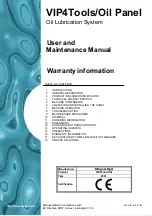
INTRODUCTION
i
SYSTEM DESCRIPTION
The Aquasafe™ Expandable Modular Water Treatment
System consists of patented individual, self-contained,
ready-to-install module assemblies. The module
assemblies may be installed as stand-alone units or
interconnected to form a complete, multi-phase system.
A module assembly may be configured to use a filter
(sediment or activated carbon), reverse osmosis
membrane, or ultraviolet lamp. Filters are selected
based on their Nominal Filter Rating (See Definition).
Definition: Nominal Filter Rating
Specification indicating the approximate size particle (in microns) that
will be retained by the filter. The filter must retain at least 85% of the
particles to achieve a specific micron rating.
NOTE:
A micron equals millionth of a meter or 0.00003937 inches.
A module assembly is available with #13 or #21
filters/sumps. The type of module assembly/system to
be installed is determined by the on-site location and
performance requirements.
Each module assembly/system is shipped with the
hardware required to attach it to the wall and fittings for
inlet/outlet and/or inter-module connections.
The Aquasafe™ System uses unique mounting brackets
that permit individual module assemblies to be rotated
for service. Connections to the system are completed
using standard plumbing fittings.
MODULE ASSEMBLY TYPES AND DESCRIPTIONS
1. Sediment
Removal: This module uses a string-
wound, polypropylene filter element rated at
5 microns.
2. Mechanical
Filtration: This module uses an activated
carbon block filter cartridge rated at either 0.5 or 10
microns. The 0.5 micron filter is available as an
Extended Pass Carbon Block (EPCB).
3. Reverse Osmosis (RO) Filtration: This module uses
a Thin Film Composite membrane element. Since
membranes consistently remove particles less than
1 micron in size, they are rated according to:
a. Daily Production: The #13 Modules have a daily
production specification of 125 gal/day (473
L/day). The #21 modules are available with an
output specification of 125 gal/day (473 L/day)
or 250 gal/day (946 L/day).
NOTE:
The daily production specification
designates the volume of permeate (treated)
water produced in 24 hours. Value is shown in
gallons per day (gal/day or GPD) and/or Liters
per day (L/day or LPD).
b. Recovery Rate: The systems are available with
a 25% or 50% Recovery Rating.
NOTE:
The Recovery Rating specifies the
percentage of influent water that is delivered as
permeate under open permeate discharge
conditions. The balance of the influent water is
used to rinse the membrane and is then sent to
the drain.
CAUTION:
Systems set for 50% Recovery
Rating must have less than 17ppm hardness.
4. Ultraviolet
(UV): A module consists of an Ultraviolet
Lamp, Transparent quartz sleeve, Stainless Steel
Channeling Sleeve (or EPCB Carbon Filter) and a
Control Box.
Options include a Lamp-Out Circuit (LOC). The
LOC provides an audible alarm or activates a
solenoid valve when the lamp goes out.
The UV module has production specifications of
2 gal/min (7.6 L/min), 4.5 gal/min (17 L/min), or 8.5
gal/min (32 L/min).
NOTE:
UV systems are rated according to the
volume of water passing through the system each
minute. This value is stated as gallons per minute
gal/min or GPM) and/or Liters per minute
(L/min or LPM).
The 2 gal/min (7.6 L/min) module contains the
UV lamp and a 0.5 micron EPCB Carbon filter.
The 4.5 gal/min (17 L/min) and 8.5 gal/min
(32 L/min) modules contain a UV Lamp and a
channeling sleeve.
If water conditions fall below the UV CONDITIONS
OF USE (Page iii, Table 1), an additional module or
modules (pre-filters) should be installed upstream of
the UV module.
5.
CAUTION:
The UV lamp requires a start-up period
of one to two minutes in order to achieve full
intensity. Repeated starting of the UV lamp will
shorten its life. Therefore, it is recommended that
the UV lamp remain on at all times during use.
Pre-filters may be may be installed in a variety of
configurations: a string-wound sediment removal
module, an activated carbon module, or a
combination of module types.


































